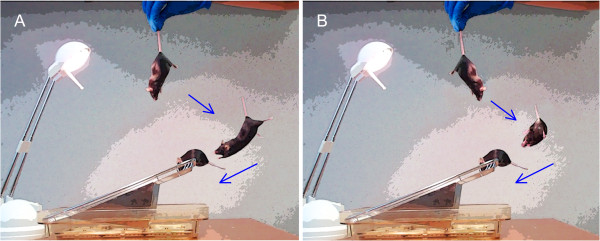Figure 1.

Slow angled-descent forepaw grasping (SLAG). (A) Approximately 15–30 cm above an illuminated wire-bar cage lid, the mouse is suspended by the tail with its ventral aspect and the raised edge of the lid toward the same side (from the viewer’s perspective, the right side). The mouse is slowly lowered according to the angle depicted by the blue arrows, and in this orientation, the wire lid remains within the mouse’s field of view throughout descent. Upon nearly passing the edge of the wire lid, the SLAG(+) mouse will stretch forth its forepaws in a sustained fashion toward the wire, whereas a SLAG(−) mouse (not depicted) will not. Finally, regardless of its performance, the mouse is placed on the wire lid for several seconds. (B) The test is immediately repeated, but with the mouse’s dorsal aspect toward the same side as the raised edge of the lid (from the viewer’s perspective, the right side). In this orientation, the wire lid becomes excluded from the mouse’s field of view when the descending mouse begins to pass the raised edge; the SLAG(+) mouse will twist around to extend its forepaws toward the wire lid in a sustained fashion, whereas a SLAG(−) mouse (not depicted) will not.
